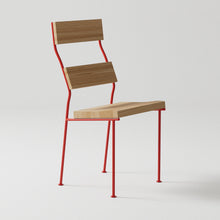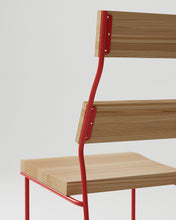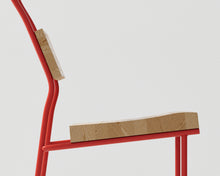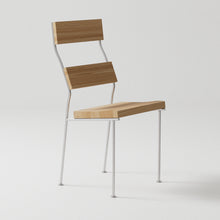AUTHOR
Johannes Norlander
DESIGNER
Sigurd Lewerentz
MATERIAL
Seat and back in solid varnished pine glulam
Slotted brass screws
DIMENSIONS
430 x 475 x 885 mm
Weight: approx. 8.6 kg
This chair is the Swedish architect Sigurd Lewerentz ́s last work. The design of the chair arose from a mockup Lewerentz developed some ten years earlier, for his brick benches in the Church of St. Peter in Klippan. The undercarriage is made of metal bars.
They are available in two variants, either painted tomato red, like the original, or in an electroplated finish. Back and seat are made of solid pine glulam, mounted with slotted brass screws.
Töreboda – A glulam chair originally designed in 1974 by Sigurd Lewerentz.
This chair is the Swedish architect Sigurd Lewerentz’s last work, completed merely a year before his death in 1975. Although intended for serial production, only a handful of copies were initially made. The design of the chair emerged from a mock-up Lewerentz developed some ten years earlier, for testing out the ergonomics of his brick benches in the St. Peter’s Church in Klippan. Lewerentz’s collaboration with the producer, the glulam manufacturer Töreboda limträ AB, had started at the middle of the century and became intensified during the construction of St. Mark’s Church in Björkhagen. Without the close relationship between the architect and the company, the chair would probably never have seen the light of the day. Important support was also provided by Bernt Nyberg, architect and close partner to Lewerentz during the final phase of his life. The
original chair, with or without armrests, was made of varnished glulam (pine) and painted steel (tomato red).
Tallum provides the original version, and a version made in electro-galvanized steel.
About Sigurd Lewerentz
Sigurd Lewerentz’s (1885–1975) oeuvre spans almost seven decades. Born in Bjärtrå in northern Sweden, Lewerentz studied architecture at Chalmers University of Technology in Gothenburg, followed by a period of apprenticeship in Germany. After settling in Stockholm, he opened his first studio in 1911.
The breakthrough came in 1915 when he, together with Gunnar Asplund, won the first prize in the International Architecture Competition for the design of a new cemetery in Stockholm (Woodland Cemetery). On his own, Lewerentz designed the Neoclassical Resurrection Chapel (1925), and he was also responsible for much of the site planning and landscaping. For the 1930 Stockholm Exhibition, Lewerentz designed such various things as housing, furniture, and graphics. In addition, he presented high-end door and window units made from metal under the brand Idesta.
The most important project from the functionalist phase was, however, the Nationa Insurance Board Building (1932).
Just a few years later his “white period” was over, and he began to develop an architecture of pronounced materiality, manifest in Villa Edstrand in Falsterbo (1937). A similar emphasis on materiality, but with more subtle detailing, characterizes the chapels St. Knut and St. Gertrud at the Eastern Cemetery in Malmö (1943).
The Malmö City Theatre (1944), Lewerentz designed in collaboration with David Helldén and Erik Lallerstedt.
At the end of his life, Lewerentz completed two unique brick churches that earned him international fame: St. Mark’s Church in Björkhagen (1960) and St. Peter’s Church in Klippan (1966). At the age of 84 he finished his last building, the iconic Flower Kiosk at the Eastern Cemetery in Malmö (1969).
About Tallum
Tallum was founded in 2018 by the architect Johannes Norlander (www.norlander.se) with the aim to reinvigorate objects made by some of the most prominent Scandinavian modernists. In Sweden, we have a rich history of architects designing furniture, something that has been neglected over time. Today we seldom see architects designing the interiors of their buildings due to commercial aspects, procurements or lack of knowledge.
Tallum is a contemporary commentary on this with the aim to elevate some of the most interesting works done in the 20th century. All our furniture is manufactured in Sweden. The main suppliers are located in the region of Småland, in the south part of Sweden. All furniture is assembled, adjusted and
shipped from our factory in Slakthusområdet, just outside Stockholm. We collaborate with suppliers that can guarantee high quality and are driven in traditional craftsmanship and understands the treasure of originality. Since the design of the furniture is made in an era with different production techniques and standards then today, we invest in reviving lost knowledge and methods to guarantee the originality of the products. Tallum is the official producer of furniture designed by Sigurd Lewerentz, Gunnar Asplund and Bernt Nyberg.
All furniture are licensed and certified by the families of the architects. Their engagement is a prerequisite for us and a guarantee for achieving authenticity.








